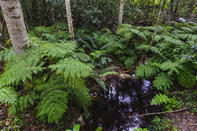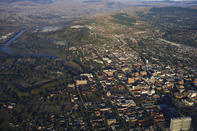Keeping the Planet Warm
The Sun's radiation penetrates the atmosphere in short ultraviolet waves. Some bounces back and some is absorbed by the Earth to be re-emitted in longer infrared waves. Small amounts of so-called (N 0) and various others - absorb this infrared heat and hold on to it long enough to keep the planet warm.

Without greenhouse gases to 'catch and hold energy, banking it against lean times', Earth would be 30°C to 40°C colder than it is now.
Enhancing the Greenhouse Effect

The composition of the atmosphere has changed constantly over time, as has the thickness of the sweater of greenhouse gases, swinging between different states of equilibrium. Carbon is recycled constantly. From the atmosphere, where carbon exists as carbon dioxide, it is absorbed by plants, which breathe some back out but convert the rest to carbohydrates, fats and proteins.
Herbivores eat the plants and store these elements in their tissues or expel some through breathing. Both release carbon back into the atmosphere when they die and rot. This is how the bulk of carbon circulates.
Occasionally carbon is banked away in ancient forms such as coal, gas, crude oil or limestone. Forests and plankton-rich oceans are regarded as 'carbon sinks' or places for the short-term storage of carbon. They are crucial in keeping balance in the system.
Methane is produced mostly through the rotting of soggy vegetation, such as the kind you would find in wetlands, marshes, bogs and the like. Herbivores also produce their share of the gas by digesting their greens. Nitrous oxide is emitted by bacteria present in the soil and by the oceans.
Humanity has interfered with these cycles. We've dug out ancient fossil fuels and burned them. We've cut down forests and burned those too. We've inundated millions of hectares with rice paddies, creating artificial wetlands that churn out methane. And the global cattle herd has grown larger and larger as we've farmed meat for the masses.
By looting carbon banks and shunting their contents back up into the atmosphere, we have altered the heat-in:heat-out equation.
Industrial Revolution

Since the mass burning of fossil fuels began with the Industrial Revolution in 1750, the amount of atmospheric carbon dioxide has increased by 31 percent, which is as high as it has ever been in the past 42 000 years and possibly even the past 20 million years.
The rate at which atmospheric carbon dioxide has increased is also significantly faster than anything seen in the past 20 000 years. Methane, the more potent greenhouse gas, has increased in the atmosphere by 151 percent during this time and nitrous oxide is up by 17 per cent. Clearly this is going to enhance the greenhouse effect.
By Leonie Joubert